- Health Conditions A-Z
- Health & Wellness
- Nutrition
- Fitness
- Health News
- Ayurveda
- Videos
- Medicine A-Z
- Parenting
'I Thought It Was Something I Ate', Woman Got Diagnosed With Stage 4 Ovarian Cancer After A Routine Ultrasound Revealed Terminal Illness

Credits: Health and me
A 57-year-old schoolteacher from Kolkata, Ruma Sen* had spent decades standing in front of classrooms, guiding young minds with poise and patience. But when her own body began to send quiet warnings—persistent bloating, fatigue that lingered, clothes fitting tighter than usual—she brushed it off. “I just assumed it was something I ate or part of aging,” she recalls. Yet, deep down, a quiet concern stirred. And then came the ultrasound that changed everything.
A mass on her left ovary. Fluid accumulating in her abdomen. The CT scan and biopsy confirmed what no one wants to hear: Stage IV high-grade serous ovarian cancer, with metastases to her intestines and abdominal lining.
“I felt like the floor had vanished beneath my feet,” Ruma says. “In that moment, the future I imagined just disappeared.”
“Ovarian cancer often whispers until it roars,” explained Dr. Debapriya Mondal, Ruma’s medical oncologist at Apollo Cancer Centre, Kolkata. “By the time it's diagnosed, it's usually advanced. But even Stage IV isn't without hope.”
This late-stage diagnosis is common with ovarian cancer, especially its most aggressive subtype—high-grade serous carcinoma. It lacks early symptoms that are easily distinguishable from benign issues like indigestion or menstrual irregularities. That’s why it’s dubbed the “silent killer.”
Round One: Chemotherapy as the First Line of Defense
Chemotherapy began within days of diagnosis. The plan was clear: shrink the tumors to make surgery safer and more effective. The process, however, was anything but clinical for Ruma.
“The first cycle made me violently nauseous. My hair fell out in clumps. I was too weak to stand some mornings,” she remembers. Despite the toll, the treatment was working. By the third cycle, imaging showed significant tumor shrinkage.
“Chemotherapy is brutal,” Dr. Mondal admits. “But when the scans show tumors shrinking, it’s our signal that we’re fighting back—and winning ground.”
Round Two: A Critical Turning Point Surgery
Ruma’s next hurdle was interval debulking surgery, a complex procedure to remove all visible tumors, followed by HIPEC (Hyperthermic Intraperitoneal Chemotherapy)—a method where heated chemotherapy is delivered directly into the abdominal cavity during surgery.
“It was the toughest part,” Ruma says. “I woke up in ICU with tubes everywhere. My abdomen felt like it was on fire.” Recovery was grueling. Ten days in the hospital marked by small but vital victories: sipping water, standing unaided, breathing without assistance.
“HIPEC is not for every patient,” Dr. Mondal says. “But in selected cases like Ruma’s, it increases the chances of a long remission or even a cure.”
Round Three: Genetic Testing and Personalized Medicine
As Ruma regained strength, her care team ordered homologous recombination deficiency (HRD) testing, a genomic analysis that helps determine how well a tumor repairs its DNA. The results revealed a germline BRCA1 mutation, a known genetic driver of ovarian cancer.
“This changed everything,” Dr. Mondal explains. “When tumors carry this mutation, we can use targeted maintenance therapy, such as PARP inhibitors, which drastically reduce the risk of recurrence.”
For Ruma, the discovery was both empowering and alarming. “I now had a new weapon against my cancer. But I also worried about what it meant for my daughters.”
She completed three more cycles of chemotherapy and transitioned to oral PARP inhibitors—medications designed to exploit her cancer’s genetic vulnerabilities. For the next two years, she remained under strict oncologic surveillance, with regular scans and bloodwork to track any signs of recurrence.
Ruma’s diagnosis didn’t just change her life—it changed her family’s trajectory.
Her two daughters, Megha** and Ananya**, underwent genetic counseling and testing. Megha, the elder at 35, tested positive for the same BRCA1 mutation. “It was a gut punch,” Megha says. “But I felt lucky to know.”
After consulting with specialists, she opted for risk-reducing salpingo-oophorectomy (RRSO)—a preventive surgery to remove her ovaries and fallopian tubes. “It meant early menopause. But it also meant I was taking control of my future,” Megha explains.
According to Dr. Mondal, this kind of cascade testing—where family members of patients with genetic mutations are screened—is vital. “We now have tools not just to treat cancer, but to prevent it. Megha’s decision may have significantly lowered her lifetime risk of ovarian and breast cancer.”
Today, Ruma is in clinical remission. She has resumed teaching, started leading yoga sessions for cancer survivors, and advocates for genetic testing and early detection. “I used to fear my body,” she admits. “Now I listen to it. I take care of it.”
She also speaks publicly about her cancer journey, helping dismantle the stigma and fear surrounding a disease that affects nearly 300,000 women worldwide each year, according to the World Health Organization.
“We are in a new era of precision oncology,” Dr. Mondal emphasizes. “We are no longer limited to one-size-fits-all treatments. Every tumor has a story written in its DNA—and we’re learning how to read it.”
Why It Is Important To Listen to Your Body?
Ruma’s story is more than a personal victory. It’s a real-world example of how modern oncology is evolving—from late diagnosis to targeted intervention, from suffering in silence to survivorship with purpose. Here’s what it tells us:
- Listen to your body, even when the symptoms seem minor.
- Early diagnosis remains rare, but genetic insights can improve long-term outcomes.
- Precision medicine—like HRD testing and PARP inhibitors—is rewriting how we approach advanced cancer.
- Genetic counseling empowers entire families, not just patients.
- And most importantly, survival is possible, even in Stage IV.
“I don’t know what the future holds,” Ruma says. “But I know I’ve done everything in my power to live it fully.”
Disclaimer: This article is based on a real-life medical journey. To protect the privacy of the individual and her family, names and identifying details have been changed. Medical information shared is for educational and awareness purposes only and should not be considered a substitute for professional medical advice, diagnosis, or treatment.
NHS Chickenpox Vaccine Explained: Eligibility Rules And Timeline For Children

Credits: Canva
Hundreds of thousands of children are set to receive an additional vaccine under the NHS routine childhood immunisation programme. Health officials have confirmed it will be given alongside the existing MMR jab, which protects children in England against measles, mumps and rubella.
Chicken pox Vaccine Starts By NHS
The decision follows advice from the Joint Committee on Vaccination and Immunisation and will see the current MMR jab replaced with a combined MMRV vaccine. This single injection protects against measles, mumps, rubella and chickenpox. Studies estimate that chickenpox in childhood leads to around £24 million a year in lost earnings and productivity across the UK. Alongside reducing this impact, the rollout is expected to save the NHS about £15 million each year in treatment costs linked to the illness.
Dr Claire Fuller, National Medical Director for NHS England, said: “This marks a very positive step for children and families, offering protection against chickenpox for the first time and strengthening the range of routine vaccinations we already give to help shield children from serious diseases.
“From now on, the combined vaccine covering measles, mumps, rubella and chickenpox will be offered at children’s routine vaccination appointments. This will help keep children healthier, prevent illness caused by these highly infectious viruses, and support the NHS shift from treating sickness to preventing it, while keeping more children safe and in school.”
Recent figures show that around half of children will have chickenpox by the age of four, with nine in ten catching it before they turn ten. Children who develop chickenpox are usually advised to stay away from school until all spots have crusted over, which typically happens about five days after the rash appears.
With the new vaccine in place, fewer children are expected to miss time at nursery or school. This should also reduce the amount of work parents need to take off to look after them.
Who Can Get The Chickenpox Vaccine On The NHS?
Protection against chickenpox is being offered through a new combined vaccine known as MMRV, which replaces the existing MMR jab. The MMRV vaccine protects against measles, mumps, rubella and varicella, the virus that causes chickenpox.
- Children born after 1 January 2026 will automatically be offered two doses of the MMRV vaccine, given at 12 months and again at 18 months.
- A catch-up programme will also provide one or two doses for older children, depending on when they were born:
- children born on or after 1 January 2025 will be offered two doses, one at 12 months and one at 18 months
- children born between 1 July 2024 and 31 December 2024 will be offered two doses, one at 18 months and another at 3 years and 4 months
- children born between 1 September 2022 and 30 June 2024 will be offered one dose at 3 years and 4 months
- children born between 1 January 2020 and 31 August 2022 will be offered a single dose later in 2026
- GP practices will contact families directly to arrange vaccination appointments when they are due.
How Does The New Chickenpox Vaccination Work?
Specialists say adding the varicella vaccine to the NHS childhood immunisation schedule will significantly cut the number of people who get chickenpox, resulting in far fewer severe cases.
While the vaccine does not guarantee lifelong immunity, it greatly lowers the chances of catching chickenpox or developing a serious form of the illness. Serious side effects, including severe allergic reactions, are extremely uncommon.
The vaccine is a live vaccine, meaning it contains a weakened form of the chickenpox virus. Because of this, it is not recommended for people with weakened immune systems due to conditions such as HIV or treatments like chemotherapy.
The change brings the UK in line with countries that already include routine chickenpox vaccination, such as Germany, Canada, Australia and the United States.
In the past, there were concerns that vaccinating children against chickenpox could lead to an increase in shingles later in life, but a large long-term study from the US has since shown this is not the case.
The Joint Committee on Vaccination and Immunisation, which advises the government, recommended the introduction of the MMRV vaccine for all children in November 2023.
The government confirmed plans to roll out the MMRV vaccine in August 2025, after new figures showed that none of England’s main childhood vaccinations reached the 95 percent uptake target in 2024 to 2025.
According to the UK Health Security Agency, 91.9 percent of five-year-olds had received one dose of the MMR vaccine. This figure was unchanged from 2023 to 2024 and remains the lowest level recorded since 2010 to 2011.
Norovirus 2025: How The Winter Vomiting Virus Hits Your Gut And Digestion

Credits: Canva
Running to the bathroom with vomiting, diarrhea, or both is never fun. Yet “stomach bugs” are a common part of life, and norovirus is often behind these outbreaks.
Norovirus is a highly contagious virus that triggers symptoms like vomiting and diarrhea, and cases are climbing this winter. While it often makes headlines during cruise ship outbreaks, most infections occur on land, anyone can catch it.
“Originally called ‘winter vomiting disease,’ norovirus is one of the leading causes of vomiting and diarrhea in both children and adults,” explains Dr. Ava Anklesaria, a gastroenterologist at Columbia who treats multiple cases each year. “The virus is very stable in the environment, and only a tiny amount is needed to infect someone, which makes it easy to spread. Simple measures like washing your hands with soap and water for 20 seconds and avoiding contact with sick individuals can prevent infection.”
In the U.S., the CDC estimates that norovirus causes about 21 million illnesses, 465,000 emergency visits—mostly among children—and around 900 deaths annually.
What Is Norovirus And Its Common Symptoms?
Norovirus causes viral gastroenteritis, sometimes called “stomach flu” or a “stomach bug,” though it isn’t related to influenza. As per Mayo Clinic, it consists of several strains of RNA viruses that inflame the stomach and intestines, causing nausea, vomiting, and diarrhea.
Symptoms usually appear one to two days after exposure and often include:
- Nausea
- Vomiting (non-bloody)
- Watery diarrhea
- Stomach cramps
- Dehydration (rare but possible)
- Fever
- Headache
- Body aches
Most people recover within one to three days, though they can still spread the virus for up to two weeks after feeling better.
Who Gets Norovirus?
Anyone can get infected. Norovirus is the leading cause of acute gastroenteritis in the U.S., affecting all ages. Young children, older adults, pregnant people, and individuals with existing health conditions are more vulnerable.
How Does Norovirus Spread?
Norovirus spreads very easily. It survives well in the environment, and only a minuscule amount is enough to infect someone. In fact, just a few particles on the head of a pin can infect over 1,000 people.
Exposure can happen through:
- Eating contaminated water or food, especially leafy greens, fresh fruit, and shellfish like oysters
- Contact with vomit or fecal particles from someone who is infected, either by touching them directly or by touching contaminated surfaces, utensils, or toys
How Does Norovirus Affect Your Gut and Digestive System?
As per the National Institute Of Health, once inside the body, norovirus targets the stomach and intestines. It inflames the lining of the gut, which disrupts normal digestion and absorption. This inflammation leads to increased fluid secretion and faster movement through the intestines, causing watery diarrhea. Vomiting occurs as the stomach reacts to the irritation.
The gut lining may also temporarily lose some of its ability to absorb nutrients and fluids, which can lead to dehydration, electrolyte imbalances, and fatigue. While symptoms usually resolve in a few days, the virus can continue to be shed in stool for up to two weeks, meaning the gut can remain a source of infection even after recovery.
NHS Issues Advice For Patients Taking Atenolol Medicine For Blood Pressure

Credits: Canva
Atenolol is widely prescribed for conditions such as high blood pressure and irregular heart rhythms. While it is suitable for many adults, some people need to be especially careful before starting the beta-blocker.
NHS guidance highlights that certain medical conditions and life stages mean a doctor should be consulted first. This includes people with low blood pressure, Raynaud’s phenomenon, or asthma, among others.
Who Should Be Careful Before Taking Atenolol?
The NHS advises speaking to a doctor before taking atenolol if you fall into any of the following groups:
- People who are trying to conceive, are already pregnant, or are breastfeeding
- People with Raynaud’s phenomenon, which can cause fingers or toes to tingle, become unusually pale, or turn blue
- People with metabolic acidosis, a condition where there is too much acid in the blood
- People with low blood pressure (hypotension) or a slower than normal heart rate
- People with lung disease or asthma
- People who have previously had an allergic reaction to atenolol or any other medicine
How Atenolol Works?
According to official NHS advice, atenolol works by slowing the heart rate, which helps the heart pump blood around the body more easily. In addition to treating blood pressure and heart rhythm problems, it is sometimes prescribed to help prevent migraines and ease symptoms of anxiety.
The NHS notes: “Atenolol is only available on prescription. It comes as tablets or a liquid that you swallow. It can also be given by injection, but this is usually only done in hospital.”
Atenol: Medicines That May Interact With Atenolol
People who take other medicines should also check with a doctor before starting atenolol, as some drugs can affect how well it works or increase the risk of side effects. This applies not only to prescription medicines but also to herbal remedies, vitamins, and supplements.
You should speak to a doctor if you take:
- Other medicines for high blood pressure, as using them with atenolol can sometimes lower blood pressure too much and cause dizziness or fainting
- Medicines for irregular heartbeats, such as amiodarone or flecainide
- Medicines for asthma or chronic obstructive pulmonary disease (COPD)
- Medicines for diabetes, especially insulin. Atenolol can make it harder to notice the usual warning signs of low blood sugar. If you experience low blood sugar without symptoms, speak to your doctor and monitor your levels carefully, particularly after exercise or before driving
- Medicines for nasal or sinus congestion, or other cold remedies, including those bought over the counter
- Medicines for allergies, such as ephedrine, noradrenaline, or adrenaline
The NHS also states: “There’s not enough information to say that herbal remedies and supplements are safe to take with atenolol. They’re not tested in the same way as pharmacy and prescription medicines, and they’re generally not tested for how they affect other medicines.”
Atenolol Dosage And How Long Can It Be Taken?
The dose of atenolol you need depends on the condition being treated. For high blood pressure, the usual adult dose is between 25mg and 50mg once a day, but you should always follow your doctor’s instructions. Your medication packaging will also provide guidance on how to take it.
How long you stay on atenolol varies as well. For long-term conditions such as high blood pressure, it is often taken for many years and, in some cases, for life.
© 2024 Bennett, Coleman & Company Limited

